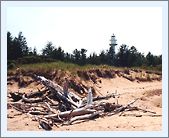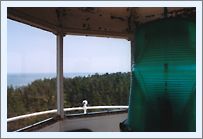|
Historical Information

By the last decade of the nineteenth century, it became clear
that the diminutive 34-foot tall tower of the 1858 LaPointe light was no
longer serving the needs of maritime traffic passing between Madeline,
Stockton and Michigan Island on its way to the busy ore docks in
Ashland. Located too far to the west, it was obscured by the southern
tip of Madeline Island until vessels were almost on top of it. In 1890
the Lighthouse Board proposed that $10,000 be appropriated to replace
the old light with a new 70-foot tall iron tower to be located next to
the fog signal building which had been constructed ¾ of a mile to the
east of the old light in 1891.
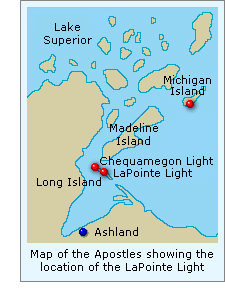 Since this new light would be located
over a mile from the northwestern tip of Long Island, it was
simultaneously proposed that a small light and fog bell be constructed
on Chequamegon Point at the northwestern tip of the island to aid
vessels rounding the point before heading south into Chequamegon bay for
Ashland. Congress was slow to respond to the Board's request, and thus
the plea was reiterated in each of the Board's annual reports for
the following four years, until Congress finally responded with the
requested appropriation on March 2, 1895. Since this new light would be located
over a mile from the northwestern tip of Long Island, it was
simultaneously proposed that a small light and fog bell be constructed
on Chequamegon Point at the northwestern tip of the island to aid
vessels rounding the point before heading south into Chequamegon bay for
Ashland. Congress was slow to respond to the Board's request, and thus
the plea was reiterated in each of the Board's annual reports for
the following four years, until Congress finally responded with the
requested appropriation on March 2, 1895.
On receipt of the appropriation,
Eleventh District Inspector, Commander William W. Mead began
negotiations for the purchase of two parcels of land on the island. One
for the new main light some 3,000 feet to the east of the 1859
structure, and 30 feet from the 1891 fog signal building, and the other
at Chequamegon Point for the construction of the small tower and fog
bell. However, with the letting of contracts for the fabrication and
delivery of the iron work for both new structures, it quickly became
clear the $10,000 appropriation was insufficient for the task, and an
additional $1,500 appropriation was requested.
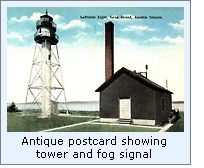 Since with the construction of the new
lights the LaPointe keepers would be responsible for two lights and a
fog signal, it was determined that a full-time assistant keeper would
need to be assigned to the station to keep up with the workload, and
additional living quarters would need to added. To keep costs within the
limits of the appropriation, Eleventh District Engineer, Major Milton B.
Adams drew up plans to modify the existing LaPointe lighthouse into a
duplex dwelling, since with the the old structure would no longer serve
any purpose with the completion of the new lights. To this end, in the
summer of 1896 the old LaPointe lighthouse was jacked-up, and a brick
basement constructed beneath, and the interior of the structure
reconfigured to accommodate two keepers. Amazingly, the light atop the
roof was kept in operation throughout the entire reconstruction, and
thus the expense of building a temporary tower was avoided. Since with the construction of the new
lights the LaPointe keepers would be responsible for two lights and a
fog signal, it was determined that a full-time assistant keeper would
need to be assigned to the station to keep up with the workload, and
additional living quarters would need to added. To keep costs within the
limits of the appropriation, Eleventh District Engineer, Major Milton B.
Adams drew up plans to modify the existing LaPointe lighthouse into a
duplex dwelling, since with the the old structure would no longer serve
any purpose with the completion of the new lights. To this end, in the
summer of 1896 the old LaPointe lighthouse was jacked-up, and a brick
basement constructed beneath, and the interior of the structure
reconfigured to accommodate two keepers. Amazingly, the light atop the
roof was kept in operation throughout the entire reconstruction, and
thus the expense of building a temporary tower was avoided.
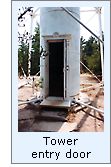 That same season, concrete foundation
piers for the new sixty-foot cast-iron tower were poured near the fog
signal building, and erection of the tower began. The new tower was
built as an 8 foot diameter cast iron central stairway cylinder with
four tubular support legs braced between the ground and the watchroom
deck. These four legs were in turn braced by horizontal tubular iron
cross members diagonally braced with iron bars equipped with and
turnbuckles to maintain rigidity of the structure. The
central cylinder itself was made up of individual cast iron segments
with flanges on each side, with each side flange bolted to the adjacent
segments. With insufficient funds to continue paying the work crew, the
worksite was abandoned after erection to the level of the watchroom
galley floor. That same season, concrete foundation
piers for the new sixty-foot cast-iron tower were poured near the fog
signal building, and erection of the tower began. The new tower was
built as an 8 foot diameter cast iron central stairway cylinder with
four tubular support legs braced between the ground and the watchroom
deck. These four legs were in turn braced by horizontal tubular iron
cross members diagonally braced with iron bars equipped with and
turnbuckles to maintain rigidity of the structure. The
central cylinder itself was made up of individual cast iron segments
with flanges on each side, with each side flange bolted to the adjacent
segments. With insufficient funds to continue paying the work crew, the
worksite was abandoned after erection to the level of the watchroom
galley floor.
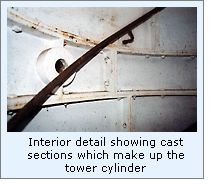 Congress finally appropriated the
additional $1,500 on July 14, 1897, and the AMARANTH returned to Long
Island with a work crew soon thereafter, and work on the island assumed
a feverish pace throughout the 1897 season of navigation. With the
Chequamegon Point tower brought to completion first, the fixed red
Fourth Order lens was removed from the old LaPointe Light and
reinstalled in the new beacon on the night of October 11, 1897 without
any change in characteristic. Congress finally appropriated the
additional $1,500 on July 14, 1897, and the AMARANTH returned to Long
Island with a work crew soon thereafter, and work on the island assumed
a feverish pace throughout the 1897 season of navigation. With the
Chequamegon Point tower brought to completion first, the fixed red
Fourth Order lens was removed from the old LaPointe Light and
reinstalled in the new beacon on the night of October 11, 1897 without
any change in characteristic.
No longer serving any purpose, both the
tower and lantern were removed from the old 1859 lighthouse, and the
opening in the roof boarded-over and re-shingled. Sewers from both side
of the dwelling were laid to the lake shore and a drive well was sunk to
the east of the dwelling to provide drinking water to sides of the
duplex. The boat house was moved from the south side of the island to
the north side where deeper waster was available, two cribs were
constructed for the boat landing, and a concrete walk was laid from the
new boat house to the modified dwelling. A workshop which had formerly
been attached to the dwelling was removed and converted into a woodshed.
 The crew then turned their attention
back to completing the the installation of the circular watchroom and
lantern on the main LaPointe light. On completion, the entire structure
was given a coat of white paint with the exception of the lantern, which
was painted black to help the station serve as a more effective daymark.
The lantern was outfitted with a new fixed white Fourth Order Fresnel
lens, which by virtue of the tower's location on elevated ground
provided the lens with a focal plane of 70 feet and a distance of
visibility of 16 miles. The crew then turned their attention
back to completing the the installation of the circular watchroom and
lantern on the main LaPointe light. On completion, the entire structure
was given a coat of white paint with the exception of the lantern, which
was painted black to help the station serve as a more effective daymark.
The lantern was outfitted with a new fixed white Fourth Order Fresnel
lens, which by virtue of the tower's location on elevated ground
provided the lens with a focal plane of 70 feet and a distance of
visibility of 16 miles.
In 1902, the landing dock was extended
through the addition of a 13 by 24 foot crib some 20 feet in front of
the old dock to which it was connected by a wood bridge. The crib in
which the water supply intake for the fog signal was located was also
rebuilt to prevent the frequent silting-up experienced with the old
intake.
 April 18, 1925 saw the electrification
of the station with the installation of a diesel engine-powered
generator. With electrification, the 10-inch steam whistles were removed
and replaced with a pair of air-powered Type T diaphone fog signals
powered by electrically driven compressors. Concurrent with the
installation of these new diaphones, the characteristic of the fog
signal was modified to a repeated 30-second cycle consisting of 3-second
blasts followed by 27 seconds of silence. Three years later in 1928, a
radio beacon was installed at LaPointe, transmitting a characteristic
3-minute cycle of 4-dash groups for 60-seconds followed by 120 seconds
of silence during thick weather, and the Fourth Order lens in the main
tower was electrified through the installation of a 9,000 candlepower
incandescent electric lamp. With electrification, the characteristic of
the light was also changed to flashing white, with a 2-second flash
followed by 3 seconds of darkness. A small automatic acetylene-powered
winter light was also installed on the gallery, to be left in operation
during the winter months when the keepers closed the station for the
season and departed for the mainland. April 18, 1925 saw the electrification
of the station with the installation of a diesel engine-powered
generator. With electrification, the 10-inch steam whistles were removed
and replaced with a pair of air-powered Type T diaphone fog signals
powered by electrically driven compressors. Concurrent with the
installation of these new diaphones, the characteristic of the fog
signal was modified to a repeated 30-second cycle consisting of 3-second
blasts followed by 27 seconds of silence. Three years later in 1928, a
radio beacon was installed at LaPointe, transmitting a characteristic
3-minute cycle of 4-dash groups for 60-seconds followed by 120 seconds
of silence during thick weather, and the Fourth Order lens in the main
tower was electrified through the installation of a 9,000 candlepower
incandescent electric lamp. With electrification, the characteristic of
the light was also changed to flashing white, with a 2-second flash
followed by 3 seconds of darkness. A small automatic acetylene-powered
winter light was also installed on the gallery, to be left in operation
during the winter months when the keepers closed the station for the
season and departed for the mainland.
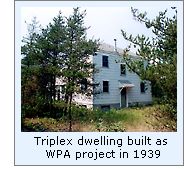 By the 1930's, it was realized that the
modified keepers dwelling located almost a mile from the main LaPointe
Light was inconveniently located and no longer served as adequate
housing for the Keeper and two assistants assigned to the station.
However, with the country in the grips of the Great Depression, the
funds for such works were understandably hard to come by. In 1938 as
part of the series of Works Progress Administration projects being
undertaken across the nation, a work crew arrived on the island and
built a large modern three-family dwelling close to the LaPointe Light
and fog signal, permitting a more efficient grouping of the structures
constituting the station. No longer serving any purpose, everything of
value was removed from the old keepers dwelling and the old 1859
building was abandoned. Without maintenance, the structure quickly
deteriorated, with the upper floors caving in, eventually leaving only
parts of the brick basement walls erected in 1897 standing as witness to
the fact that a building of historical significance ever stood on the
spot. By the 1930's, it was realized that the
modified keepers dwelling located almost a mile from the main LaPointe
Light was inconveniently located and no longer served as adequate
housing for the Keeper and two assistants assigned to the station.
However, with the country in the grips of the Great Depression, the
funds for such works were understandably hard to come by. In 1938 as
part of the series of Works Progress Administration projects being
undertaken across the nation, a work crew arrived on the island and
built a large modern three-family dwelling close to the LaPointe Light
and fog signal, permitting a more efficient grouping of the structures
constituting the station. No longer serving any purpose, everything of
value was removed from the old keepers dwelling and the old 1859
building was abandoned. Without maintenance, the structure quickly
deteriorated, with the upper floors caving in, eventually leaving only
parts of the brick basement walls erected in 1897 standing as witness to
the fact that a building of historical significance ever stood on the
spot.
Both the Chequamegon and LaPointe
Lights were fully automated in 1964, and the final crew of Coast
Guardsmen to man the station departed, leaving the maintenance of the
structures to the crew at the Devils Island Light which remained manned
to serve all of the Apostle Islands lights until 1978.
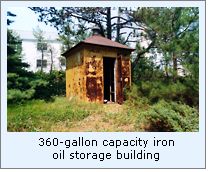 Although the formation of the Apostles
Island National Lakeshore on September 26, 1970 assured the long-term
survival of the remaining Apostle Islands lighthouses, Long Island was
not included as part of the National Lakeshore until 1986, when the Park
boundaries were expanded to include Long Island and Congress passed
legislation transferring all lands within the Apostle Islands National
Lakeshore Park boundaries over to the NPS, and in a single stroke of the
pen all of the Coast Guard properties within the park were
simultaneously moved into NPS ownership. Although the formation of the Apostles
Island National Lakeshore on September 26, 1970 assured the long-term
survival of the remaining Apostle Islands lighthouses, Long Island was
not included as part of the National Lakeshore until 1986, when the Park
boundaries were expanded to include Long Island and Congress passed
legislation transferring all lands within the Apostle Islands National
Lakeshore Park boundaries over to the NPS, and in a single stroke of the
pen all of the Coast Guard properties within the park were
simultaneously moved into NPS ownership.
Since Long Island was the last of the
Apostle to be added to the National Lakeshore, little has been done to
the LaPointe station beyond basic stabilization. However, the National
Park has plans to begin restoration of both structures, and it is hoped
that they will be maintained for future generations to enjoy long into
the next century.

Keepers of
this Light

Click here
to see a complete listing of all LaPointe Light keepers compiled by
Phyllis L. Tag of Great Lakes Lighthouse Research.

Seeing this Light

For five days in July, 2002, we were privileged to serve as NPS
volunteers, assisting Park Historian Bob Mackreth in documenting the
condition of all the Apostle Islands Lights, and visited Long Island in
a Boston Whaler on the afternoon of our first day in the Apostles after
spending the morning on Outer Island.
After tying up at the dock in front of the station, we walked up the
overgrown pathway to the station. The LaPointe Light is the only one of
the Apostle Islands Lights that is not open to the public during summer
hours, and as such the tower is not generally open to the public. Since
the light still serves as an active aid to navigation, the door was
secured with a double padlock mechanism, containing both NPS and Coast
Guard padlocks. On entering the central tower cylinder, we we
immediately noticed the individual cast iron segments which were bolted
together to form the walls of the cylinder. We were impressed with the
common sense engineering represented by this design, as it would have
made shipment and unloading of the components at the site relatively
easy, as opposed to having to ship and unload large fully cylindrical
segments.
As a result of the 95 degree heat on the day we visited, the temperature
within the stair cylinder was oppressively hot, and we appreciated the
cool breeze as we stepped out onto the gallery to gain an impressive
view the island. Looking down from the tower, we could see the concrete
foundation of the old fog signal building, which was razed at the time
of the station's automation.

Finding this Light

At
this time, the LaPointe Light is the only station in the Apostles which
is not open to the public on a regular basis. However, the island itself
is open to the public, and good views of the exteriors of the tower and
dwelling can be obtained. A private boat is needed to make landfall on
Long Island for all but two weeks of the year. While Apostle
Island Cruise Service offers daily trips around the islands,
passing close to the island for photography, it is only during the two
weeks of the annual Keeper of The Light festival in September that they
offer landings on Long Island.

Contact information
Apostle Island Cruise Services may be
contacted at the following address:
P.O. Box 691 - City
Dock
Bayfield, WI 54814
Telephone: (800) 323-7619
Email: info@apostleisland.com
For information on the Keeper
Of The Light Celebration, contact:
PO Box 990 19 Front St.
Bayfield, WI 54814
Telephone: (800) 779-4487

Historical
references

Annual reports of the lighthouse Board, various, 1853 - 1909
Annual reports of the Lighthouse Service, various, 1910 - 1953
Great Lakes Light Lists, various, 1861 - 1977
Annual reports of the Lake Carrier's Association, various, 1906 -
1940
Personal observations made during our trip to Long Island in July, 2001.
Recent photograph courtesy of the NPS Historian's office.
Historic photographs courtesy of the USCG and NPS historians offices.
Email correspondence with Bob Mackreth NPS, various, January &
February 2002
Keeper listings for this light appear
courtesy of Great
Lakes Lighthouse Research
|
